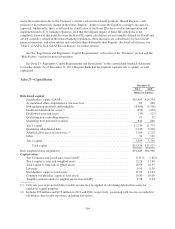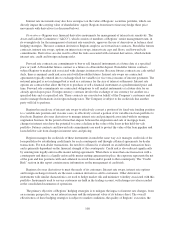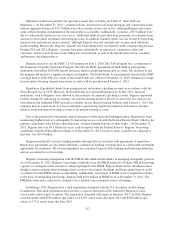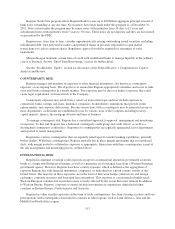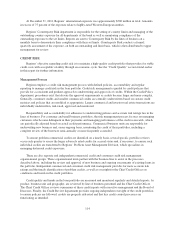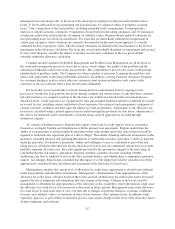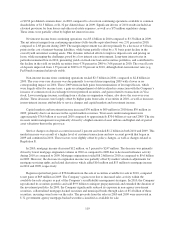Regions Bank 2011 Annual Report Download - page 136
Download and view the complete annual report
Please find page 136 of the 2011 Regions Bank annual report below. You can navigate through the pages in the report by either clicking on the pages listed below, or by using the keyword search tool below to find specific information within the annual report.Maturities in the loan portfolio also provide a steady flow of funds (see Table 11 “Selected Loan
Maturities”). At December 31, 2011, commercial loans and investor real estate mortgage and construction loans
with an aggregate balance of $12.9 billion were due to mature in one year or less, although Regions may renew
some of these lending arrangements if the risk profile is acceptable. Additionally, securities of $73 million were
due to contractually mature in one year or less. Additional funds are provided from payments on consumer loans
and one-to-four family residential first mortgage loans. In addition, liquidity needs can also be met by borrowing
funds in state and national money markets, although Regions does not currently rely on unsecured wholesale
market funding. Historically, Regions’ liquidity has been enhanced by its relatively stable customer deposit base.
During 2010 and 2011, Regions’ customer base grew substantially in response to competitive offers and
customers’ desire to lock-in rates in the falling rate environment, as well as the introduction of new consumer
and business checking products.
Regions elected to exit the FDIC’s TAG program on July 1, 2010. The TAG program was a component of
the Temporary Liquidity Guarantee Program, whereby the FDIC guaranteed all funds held at participating
institutions beyond the $250,000 deposit insurance limit in qualifying transaction accounts. The decision to exit
the program did not have a significant impact on liquidity. The Dodd-Frank Act permanently increased the FDIC
coverage limit to $250,000. As a result of the Dodd-Frank Act, effective December 31, 2010, unlimited coverage
for non-interest bearing demand transaction accounts will be provided until January 1, 2013.
Regulation Q prohibited banks from paying interest on business checking accounts in accordance with the
Glass-Steagall Act of 1933. However, the Dodd-Frank Act repealed Regulation Q. In July 2011, financial
institutions, such as Regions, were allowed to offer interest on corporate checking accounts. Regions responded
to these changes by enhancing its existing core interest-bearing products. However, due to the low interest rate
environment and unlimited FDIC insurance available on non-interest bearing balances until January 1, 2013, the
company has not experienced, nor does it anticipate experiencing significant migration of business customer
balances from non-interest bearing accounts to an interest-bearing account.
Due to the potential for uncertainty and inconsistency in the unsecured funding markets, Regions has been
maintaining higher levels of cash liquidity by depositing excess cash with the Federal Reserve Bank, which is the
primary component of the balance sheet line item, “interest-bearing deposits in other banks.” At December 31,
2011, Regions had over $4.9 billion in excess cash on deposit with the Federal Reserve. Regions’ borrowing
availability with the Federal Reserve Bank as of December 31, 2011, based on assets available for collateral at
that date, was $19.4 billion.
Regions periodically accesses funding markets through sales of securities with agreements to repurchase.
Repurchase agreements are also offered through a commercial banking sweep product as a short-term investment
opportunity for customers. All such arrangements are considered typical of the banking and brokerage industries
and are accounted for as borrowings.
Regions’ financing arrangement with the FHLB adds additional flexibility in managing its liquidity position.
As of December 31, 2011, Regions’ borrowing availability from the FHLB totaled $5.4 billion. FHLB borrowing
capacity is contingent on the amount of collateral pledged to the FHLB. Regions Bank and its subsidiaries have
pledged certain residential first mortgage loans on one-to-four family dwellings and home equity lines of credit
as collateral for the FHLB advances outstanding. Additionally, investment in FHLB stock is required in relation
to the level of outstanding borrowings. Regions held $219 million in FHLB stock at December 31, 2011. The
FHLB has been and is expected to continue to be a reliable and economical source of funding.
In February 2010, Regions filed a shelf registration statement with the U.S. Securities and Exchange
Commission. This shelf registration does not have a capacity limit and can be utilized by Regions to issue
various debt and/or equity securities. The registration statement will expire in February 2013. In 2010, Regions
issued from the shelf $250 million (par value) of 4.875% senior notes due April 2013 and $500 million (par
value) of 5.75% senior notes due June 2015.
112




